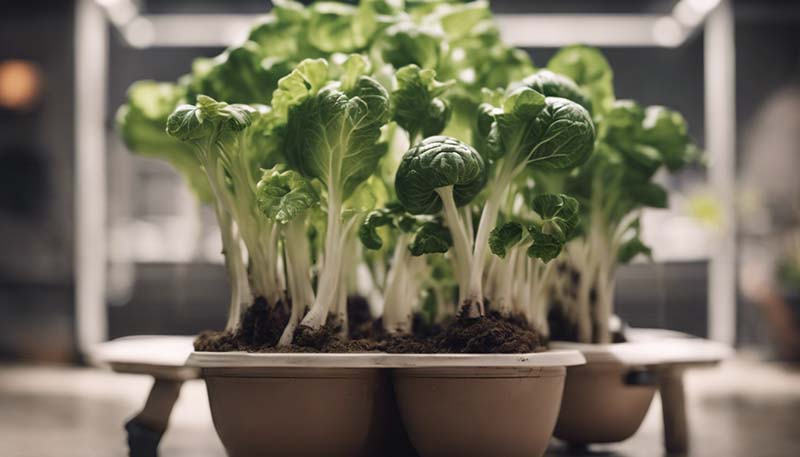Indoor Gardening: How to Grow Fruits and Vegetables Indoors
Growing your own fruits and vegetables indoors can be a rewarding and healthy hobby. Not only does it provide you with fresh produce, but it can also be a therapeutic and educational experience. In this guide, we will cover the basics of indoor gardening, including selecting the right plants, setting up your indoor garden, and providing the necessary care for your plants to thrive.
1. Choose the Right Plants
When starting an indoor garden, it's essential to choose plants that are suitable for indoor growth. Some fruits and vegetables are more forgiving and can adapt well to indoor conditions. Here are a few options to consider:
- Leafy greens: lettuce, spinach, kale, and arugula
- Herbs: basil, parsley, cilantro, and mint
- Root vegetables: radishes, carrots, and beets
- Tomatoes: cherry and grape varieties
- Peppers: bell and chili
- Cucumbers and zucchini
- Strawberries and blueberries
2. Select the Right Containers
Containers play a crucial role in the health and productivity of your indoor garden. They should be made of breathable material, have proper drainage, and be the appropriate size for your plants. Here are some container options:
Advertisement
- Plastic pots: lightweight and affordable
- Ceramic pots: stylish and available in various sizes
- Fabric pots: allow for better root growth and aeration
- Recycled containers: repurpose cans, buckets, or even shoes
Remember to add drainage holes to your containers if they don't have them already.
3. Use Quality Soil
The soil you use for your indoor garden is just as important as the plants themselves. Good quality soil provides the necessary nutrients for your plants to grow. Here are a few soil options:
- Organic potting mix: a blend of peat moss, compost, and other organic materials
- Coarse sand: improves drainage and aeration
- Perlite or vermiculite: lightweight and helps retain moisture
- Compost: adds nutrients and improves soil structure
Avoid using garden soil as it may contain pathogens and pests that can harm your indoor plants.
4. Provide Adequate Lighting
Indoor plants require a significant amount of light to grow and produce fruit. Here are some lighting options for your indoor garden:
- South-facing windows: provide the most sunlight
- East or west-facing windows: also offer good light, but for shorter periods
- Grow lights: use artificial lighting if natural light is insufficient
- LED grow lights: energy-efficient and produce less heat
Rotate your plants every few days to ensure even light exposure.
5. Water Properly
Overwatering is a common mistake in indoor gardening. Here are some tips for proper watering:
- Check the soil moisture before watering
- Water until water drains out of the bottom of the container
- Avoid letting your plants sit in standing water
- Use room temperature water to avoid shocking your plants
Watering needs will vary depending on the plant type and the environment, so monitor your plants closely.

6. Fertilize Regularly
Indoor plants require regular feeding to maintain their health and productivity. Here are some fertilization tips:
- Use a balanced fertilizer for most plants
- Follow the package instructions for the correct dosage
- Fertilize less frequently during the winter months
- Avoid over-fertilizing, which can cause nutrient burn
Some plants, like tomatoes and peppers, benefit from higher levels of phosphorus and potassium, which promote fruit production.
7. Pest and Disease Management
Keep an eye out for common pests like aphids, spider mites, and whiteflies. Use the following methods to manage pests:
- Inspect your plants regularly for signs of infestation
- Remove pests manually or use insecticidal soap
- Introduce beneficial insects, like ladybugs, to control pests naturally
- Isolate infected plants to prevent the spread of diseases
Good air circulation and proper watering can help prevent fungal diseases.
8. Pruning and Training
Pruning and training your indoor plants can help them grow more efficiently and produce more fruit. Here are some tips:
- Remove dead or yellowing leaves to promote new growth
- Prune leggy growth to encourage bushier plants
- Train vines to grow upwards using trellises or stakes
- Pinch off flowers on plants that are not yet mature
Pruning and training should be done carefully to avoid damaging the plant.
9. Harvesting
Harvesting your indoor-grown fruits and vegetables can be a satisfying experience. Here are some harvesting tips:
- Harvest fruits and vegetables when they are fully ripe for the best flavor
- Use clean, sharp tools to avoid damaging the plant
- Harvest in the morning when the produce is at its peak freshness
- Rotate your harvest to prevent overloading one area of the plant
Some plants, like tomatoes and peppers, can continue to produce fruit if you harvest regularly.
10. Enjoy and Share Your Harvest
Nothing beats the taste of homegrown produce. Enjoy your fruits and vegetables in salads, smoothies, or as a side dish. Share your harvest with friends and family, and inspire them to start their own indoor garden.
Remember, indoor gardening is a learning process. Don't be discouraged if you encounter challenges along the way. With patience and practice, you'll be on your way to a thriving indoor garden.
Happy gardening!
Comment